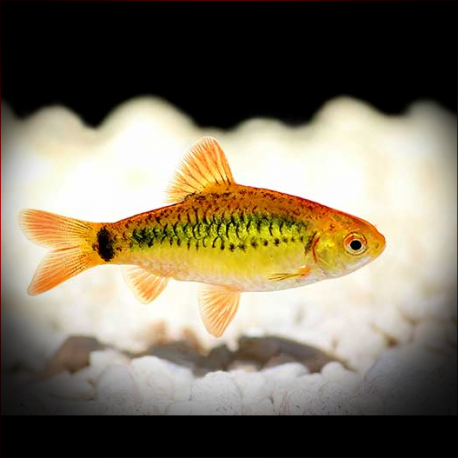Barbodes Semifasciolatus
Cypriniformes Print
More info
Datasheet
| Minimum Tank Size | 80 litres / 21.13 US gallons |
| Maximum Size | 7.5cm / 2.95inches |
| Temperature | 16°C / 60.80°F - 24°C / 75.20°F |
| Hardness | 2.02dgH / 36ppm - 20.00dgH / 357ppm |
| pH | 6.0-8.0 |
General Description
The Barbodes Semifasciolatus, commonly known as the Golden Barb, exhibits an attractive golden hue due to selective breeding. This species, part of the Cyprinidae family, reaches a maximum size of 7.5cm. It is an omnivore, feeding on benthic diatoms, algae, small insects, and more, both in the wild and in a tank setup.
Aquarium Setup
When setting up an aquarium for the Golden Barb, it is recommended to provide a mix of live and frozen foods alongside quality dried flakes. A tank of at least 80 liters with soft to moderately hard water (36-357ppm), a pH range of 6.0-8.0, and a temperature of 16-24°C is suitable. Decorate the tank with plants, driftwood, and gentle filtration.
Behaviour
This species is known for its peaceful demeanor, making it an excellent addition to a community tank. In groups of 8-10 mixed-sex individuals, they exhibit interesting interactions, especially during mating displays. The presence of schooling fish enhances their sense of security and natural behavior.
Feeding and Diet
Golden Barbs are foraging omnivores consuming a varied diet in nature. In an aquarium, they thrive on small live and frozen foods like bloodworms and Daphnia alongside high-quality flake and granule foods rich in plant or algal content. Regular feeding ensures vibrant coloration and overall health.
Reproduction & Dimorphism
These egg-scattering free spawners show no parental care. To breed Golden Barbs, provide a separate tank with dim lighting and mesh or plants for egg-laying. Gravid females can be introduced to males for spawning, resulting in hatchlings within 24-48 hours. Adult females are slightly larger than males, with mature males displaying red pigmentation on the lower body.
Habitat and Distribution
These barbs are commonly found in slow-flowing tributaries, swamps, and irrigation channels with dense vegetation across Vietnam, Taiwan, China, Laos, and possibly Russia. Their preference for warm, shallow waters with pH around 8.0 highlights their adaptability to various habitats. In Taiwan, habitat destruction and invasive species pose threats to their populations.

